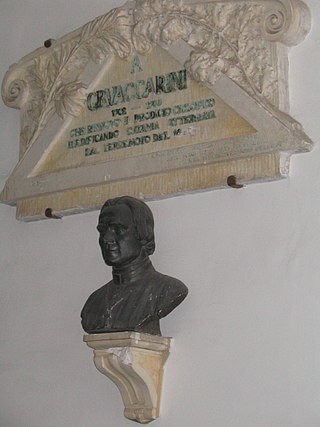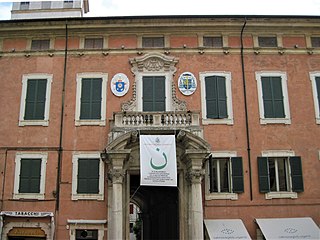
Giovanni Battista Vaccarini was a Sicilian architect, notable for his work in the Sicilian Baroque style in his homeland during the period of massive rebuilding following the earthquake of 1693. Many of his principal works can be found in the area in and around Catania.

The Palazzo Barberini is a 17th-century palace in Rome, facing the Piazza Barberini in Rione Trevi. Today, it houses the Galleria Nazionale d'Arte Antica, the main national collection of older paintings in Rome.

The Palazzo Venezia or Palazzo Barbo, formerly Palace of St. Mark, is a palazzo (palace) in central Rome, Italy, just north of the Capitoline Hill. The original structure of this great architectural complex consisted of a modest medieval house intended as the residence of the cardinals appointed to the church of San Marco. In 1469 it became a residential papal palace, having undergone a massive extension, and in 1564, Pope Pius IV, to win the sympathies of the Republic of Venice, gave the mansion to the Venetian embassy to Rome on the terms that part of the building would be kept as a residence for the cardinals, the Apartment Cibo, and that the republic would provide for the building's maintenance and future restoration. The palace faces Piazza Venezia and Via del Plebiscito. It currently houses the National Museum of the Palazzo Venezia.

Palazzo Braschi is a large Neoclassical palace in Rome, Italy and is located between the Piazza Navona, the Campo de' Fiori, the Corso Vittorio Emanuele II and the Piazza di Pasquino. It presently houses the Museo di Roma, the "Museum of Rome", covering the history of the city in the period from the Middle Ages through the nineteenth century.

The Palazzo Muti is a large townhouse in the Piazza dei Santi Apostoli, Rome, Italy, built in 1644. Together with the neighboring Palazzo Muti Papazzurri, it originally formed part of a complex of adjoining palazzi and other houses owned by the Muti Papazzurri family. During the 18th century this entire range of buildings was, by courtesy of the Pope, the residence of the Stuart dynasty while in exile in Rome. They were recognised by the Catholic Church as the rightful kings of Great Britain and Ireland. The Palazzo Muti should not be confused with the Palazzo Muti Papazzurri in the Piazza della Pilotta which was designed by Mattia de' Rossi in 1660.

Palazzo Borghese is a palace in Rome, Italy, the main seat of the Borghese family. It was nicknamed il Cembalo due to its unusual trapezoidal groundplan; its narrowest facade faces the River Tiber. The entrance at the opposite end of the building, the "keyboard" of the cembalo, faces onto the Fontanella di Borghese, with another in a great flanking facade to the Piazza Borghese that is extended by a slightly angled facade leading down Via Borghese towards the river. Both these entrances lead into a large courtyard on one side of which is a two level open arcade, with paired Doric and Ionic columns, that frames the garden beyond.

The Chigi Palace is a palace and former noble residence in Rome which is the seat of the Council of Ministers and the official residence of the Prime Minister of Italy. Since 22 October 2022, the tenant of the Chigi Palace has been Prime Minister Giorgia Meloni, although she doesn't live in the building. It is located in the Piazza Colonna, next to Palazzo Montecitorio, seat of the Chamber of Deputies.

The Doge's Palace is a historical building in Genoa, northern Italy.

Palazzo Aragona Gonzaga, also known as Palazzo Negroni, is a sixteenth-century palace in Rome, Italy. It was once the residence of Cardinal Scipione Gonzaga. During that time his cousin Luigi Gonzaga also lived there, as did the poet Torquato Tasso from 1587 to 1590. In the nineteenth century it belonged to the Galitzin family, and so is also known as Palazzo Galitzin.

The Palazzo dei Consoli is a Gothic architecture, civic building in the historic center of Gubbio, region of Umbria, Italy. Construction took place during 1332–1349 under design by Angelo da Orvieto; the palace was built on a large platform built against the hillside and looming over the town below.

Palazzo dei Convertendi is a reconstructed Renaissance palace in Rome. It originally faced the Piazza Scossacavalli, but was demolished and rebuilt along the north side of Via della Conciliazione, the wide avenue constructed between 1936 and 1950, which links St Peter's Basilica and the Vatican City to the centre of Rome. The palace is famous as the last home of the painter Raphael, who died there in 1520.

The Praetorian Palace, also known as Palace of the Eagles, is a palace of Palermo. The building has an important role in the political life of the city, since it houses the mayor and the offices of the municipality of Palermo. It is located in the heart of the historic centre, between Via Maqueda, Piazza Pretoria and Piazza Bellini, in the same area of other well-known architectural landmarks like the Fontana Pretoria, the Baroque church of Santa Caterina and the Medieval churches of Martorana and San Cataldo.

The Palazzo degli Anziani also known as the Palazzo del Comune, della Comunitá or del Giano is a Gothic-style stone palace located in the ancient historic center of Pistoia, Tuscany, Italy. The palace served as city hall for centuries; it still belongs to the comune and now mainly houses the Museo Civico d'Arte Antica.

The palazzo Belimbau, also known as palazzo Antoniotto Cattaneo or Palazzo Francesco De Ferrari, is a building located in Piazza della Nunziata at number 2 in Genoa, included on 13 July 2006 in the list of the 42 palaces inscribed in the Rolli di Genova that became World Heritage by UNESCO on that date.

The Palazzo Vincenzo Imperiale is a building located in Campetto at number 8a, in the area of the Soziglia Market in the historical centre of Genoa. The building was included in the list of palaces included in the Rolli di Genova, UNESCO World Heritage List sites. Designed and decorated in the second half of the 16th century by Giovan Battista Castello, it constitutes one of the major Mannerist creations in Liguria.

Palazzo Costaguti, also known as Palazzo Patrizi Costaguti, is a mannerist architecture Roman, located at the corner of Piazza Mattei with Via della Reginella, in rione Sant’Angelo in Rome.

The Palazzo della Ragione of Ferrara was located in Piazza Trento e Trieste on the corner of Corso Porta Reno. It was built between 1315 and 1325, modified several times and finally demolished after the fire that destroyed it in 1945. A new palace was built in its place, designed by Marcello Piacentini.

The Archiepiscopal palace of Ferrara, commissioned by the cardinal legates Tommaso Ruffo, was built in its recent form starting from 1717. It is located in Corso Martiri della Libertà next to the Cathedral of San Giorgio.

























